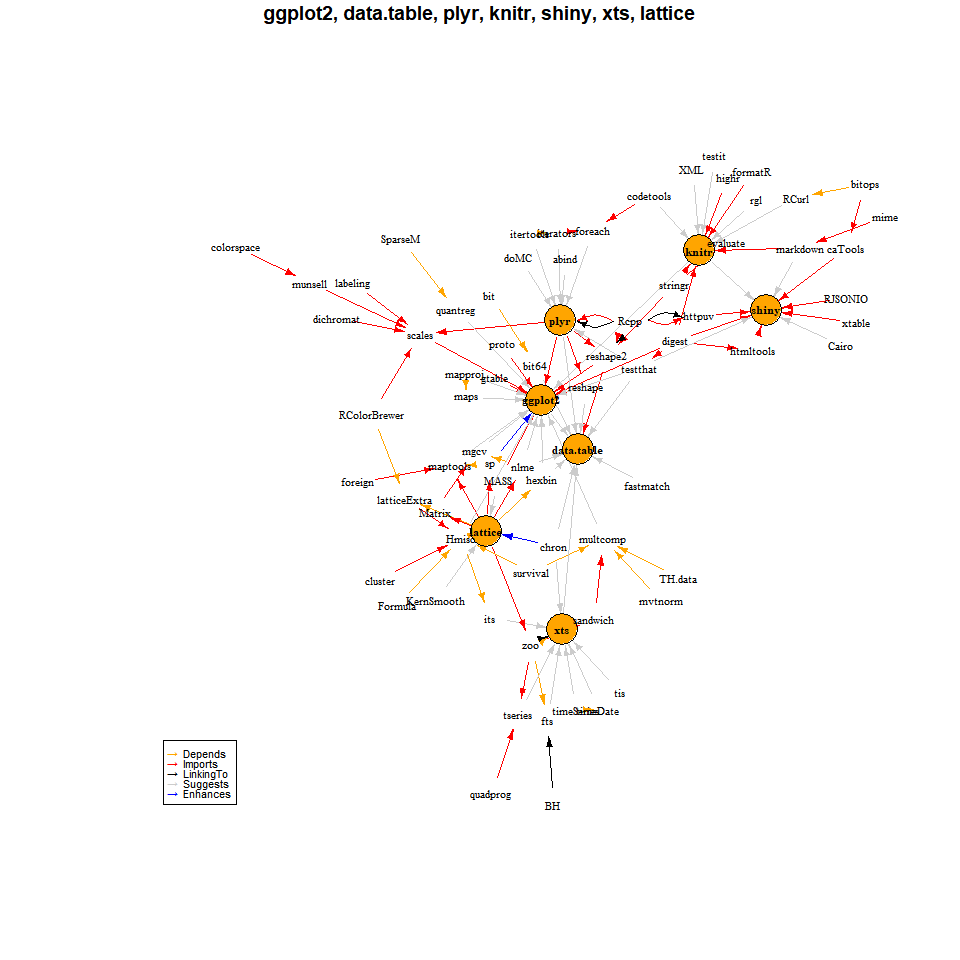Week 6 Centrality and Centralization
In Week 5, we explored a range of network-level measures, including size, density, diameter, average path length, centralization, reciprocity, transitivity, clustering coefficient, and so on. There are other interesting measures not covered by the textbook but worth your attention:11
Cohesion: The degree to which actors are connected directly to each other by cohesive bonds.Structural cohesion: The minimum number of members who, if removed from a group, would disconnect the group.
You have done a phenomenal job digging into different concepts and measures and sharing your findings back to our community via annotations.
Since some of you mentioned other R packages for SNA (such as network), I want to take this opportunity to mention that there is a “universe” of R packages, the dependencies among which can be visualized as a giant graph (see this page). Among these packages, there are many packages developed for SNA. Different packages use different names for the same measure. For instance, the network package computes a network’s density using the network.density function; in igraph, edge_density is used to compute network density.

Please make sure to check our Hypothesis annotations to learn about contributions from other colleagues. If there are burning questions, please continue the discussion on Slack.
This week, we will:
- Engage with node-level measures in social networks
- Understand how network-level and node-level measures are connected
- Learn to calculate node-level measures using igraph (or other tools)
6.1 Centrality and Centralization: An Overview
When we consider the importance of a node in a social network, how central it is usually an important consideration. In Week 4, we were able to use sociograms to identify central nodes in a network. How can we identify those central nodes mathematically in case they are not easily visually identifiable?
Centrality is a key measure in SNA developed to achieve this goal. SNA researchers have developed many ways to quantify centrality in a network. Below, I curate a list of quality resources for you to explore different centrality measures. I selected these resources because of varied ways they present centralities – equations vs. intuitions, real-world examples vs. toy networks, step-by-step demonstrations vs. one-step computation.
First, review the PDF presentation (also embedded below) presenting four main centrality measures: Degree Centrality, Betweenness Centrality, Closeness Centrality, and Eigenvector Centrality. Note that the author introduces node-level centrality and network-level centralization together in this presentation. These two concepts are often mistakenly treated as the same by researchers. Now you see their differences and connections. Also, if you could follow the math equations, that would be great; if not, please focus on the intuitions.
Second, watch the following video from Lada Adamic covering Degree Centrality, Betweenness Centrality, and Closeness Centrality with concrete examples. She also made an attempt to distinguish centralities from centralization. She also noted that when considering centrality, it is very important to be clear about the scope, or the boundary like we discussed in Week 4. A little tweak will make a difference.
6.2 Betweenness Centrality
Diving deeper, betweenness centrality is probably the most popular centrality measure I’ve personally seen in educational research. The notion of residing in-between has strong implications for many scenarios, either for facilitating/blocking access to resources or catalyzing creativity. So I think betweenness centrality is worth further exploration.
Below is a great video made by James Cook to explain betweenness centrality. Enjoy!
6.3 Eigenvector Centrality
Eigenvector centrality is another centrality measure that is well aligned with the social capital theory. Watch the following video by Lada Adamic to find out more.
6.4 Week 6 Activities
6.4.1 Readings
None. The textbook does not provide a specific introduction to node-level centrality measures.
But you’re encouraged to look back into example papers you selected in Week 3 to see whether you’ve developed any fresh understanding after diving deeper into these measures. Please (re)annotate as you look back into these example papers. Also share your findings with the class on Slack.
6.4.2 Lab 3(a): Compute Node-level Measures
Building on the first two labs, Lab 3 will extend into the next three weeks.
Like the previous week, you can continue to use a dataset you have, either your own dataset or a public one.
Two important benefits of using R (or other script-based analysis software) is reusability and reproducibility. That means, we can often reuse scripts we wrote before and expect consistent results.
The R scripts below are largely drawn from Lab 1. I added a few lines to compute betweenness centrality using betweenness(g). You are encouraged to take a look at results from these different lines and tweak other parameters to see how the results might change.
To compute other centrality measures, search “centrality” on the igraph doc page and try different functions. Again, you are encouraged to use your own dataset.
Like earlier weeks, share your findings, noticings, scripts on Slack. If you have any questions or ideas, please share with the community as well.
### Lab 3
### Source of dataset: http://networkrepository.com/soc-karate.php
# Read data ---------------------------------------------------------------
# read data from the .csv file
# karate <- read.csv("soc-karate.csv")
karate <- read.csv(file.choose())
karate <- as.matrix(karate)
# show the data in Console
karate
# Load igraph and create a network object ---------------------------------
# load the library
library(igraph)
# create a network/graph object
g <- graph_from_edgelist(karate, directed = FALSE)
# show the graph in console
g
# Compute centrality measures ---------------------------------------------
betweenness(g)
betweenness(g, directed = FALSE)
betweenness(g, directed = FALSE, normalized = TRUE)